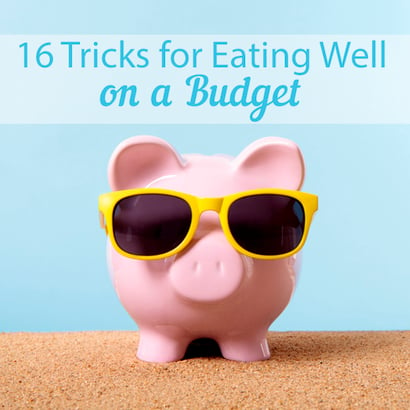
Eating on a tight budget is hard. Eating healthily on a tight budget is even harder. However, with a little bit of planning and some clever tricks up your sleeve, eating well on a budget is definitely achievable.
Here are 16 tricks to help you eat well without breaking the bank:
Have a plan. Creating a meal plan will not only help save you money, but it will also reduce any stress associated with cooking or shopping – and keep you away from any bad choices! Write down what meals you are going to eat for breakfast, lunch, dinner, and snacks for a full week.
Make a grocery list. There’s really no better way to stay organized and avoid buying items you don’t need. Build a habit of making a grocery list once a week or before each trip to the store. Use your eating plan to decide what ingredients you need to buy for the week, and what quantities you need.
Eat what’s in season. Ever notice how expensive asparagus is in January? Produce that’s in season will always be a lot less expensive. Learn which veggies and fruits are in season, and base your meals on those choices to save some cash.
Check for savings. Coupon clipping is super helpful with savings. Better yet, download a grocery rebate app. Using a rebate app will give you some cash back after shopping. Cha-ching!
Buy in bulk. If you’re buying groceries for a family, it might make sense to buy in bulk. Choose a store like Costco or Sam’s Club to do your grocery shopping. While buying in bulk can be more expensive at the time, your groceries should last longer and save you money in the long-run.
Buy from bulk bins. Get your spices, grains, and seeds from the bulk bins. Bulk bins usually cost less per ounce than the packaged versions. You’ll also be able to control how much you’re buying, which will keep your cabinets clear of expired spices and grains.
Switch to frozen. Believe it or not, frozen fruits and veggies are still just as nutritious as their fresh counterparts. Plus, frozen produce isn’t packed full of added sodium and sugars that canned fruit and veggies are. Frozen produce is also less expensive, making it an ultimate win/win for you.
Eat less meat. Eating less meat will save you money. It’s often the most expensive part of your meal. However, getting the protein that you need is a necessity! Substitute beans and lentils instead of meat to get a filling, nutritious dose of protein – for a fraction of the price!
Buy whole foods. Buy blocks of cheese instead of shredded, packaged cheese. Buy your leafy greens separately instead of purchasing prepackaged salad kits. Although these products can be convenient, they can add some significant dollars to your grocery bill.
Repurpose leftovers. Leftovers are your best friend when you’re on a budget. Repurposing leftovers also helps reduce food waste. Turn those leftover ingredients into healthy wraps, sandwiches, salads, or soups to bring to work the next day. Check out this article for some leftover recipe inspiration.
Start a garden. Grow your own herbs and veggies! Starting a small garden at your home won’t take up nearly as much time or space as you would imagine. It’s the cheapest – and most satisfying – way to get your greens.
Keep food fresh. Invest in proper Tupperware and storage utensils to help your food last longer. A vacuum-sealing tool such as FoodSaver is a great investment, especially if you regularly throw away spoiled food.
By generic brands. No need for brand-name products because generic brands are just as good! Generally, the ingredient lists will be nearly identical. Enjoy the same quality of food for a much lower price!
Do your math. Keep track of prices while you shop. Use the calculator on your phone to estimate how much you’re spending to keep yourself from going over your budget. No one likes a surprise at the checkout line!
Eat more whole grains and beans. Whole grains and beans are fairly inexpensive healthy food staples. The meal possibilities are endless, with foods like quinoa, brown rice, and black beans. Eating more of these foods will keep your body and wallet happy!
Shop around. Try different stores. You might be surprised by what deals you can find at ethnic markets, farmers' markets, and discount stores like Aldi. Don’t be afraid to branch out from your local supermarket and go exploring for more variety and better prices.
Eating well doesn’t have to cost you big bucks – it can actually help save you some money! Cooking a meal at home will generally always be less expensive than going out to eat at a restaurant. Not to mention, many healthy foods can be more filling and less expensive than junk food. Start using some of these tricks to keep yourself physically and financially healthy.
What helps you save money while eating healthily? Share your comments below!



